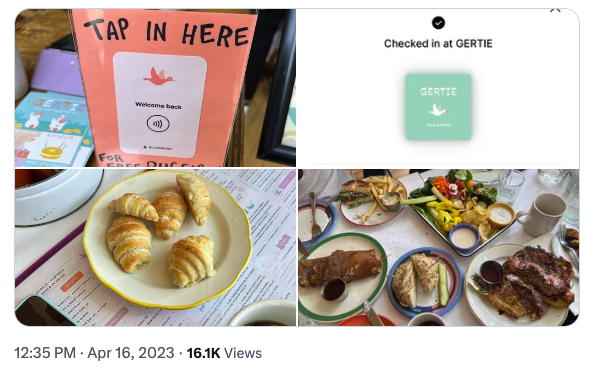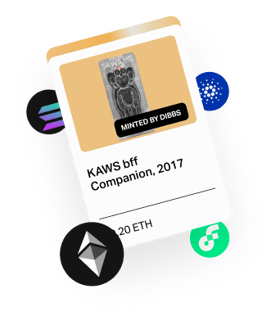Web2 Brands with NFTs are Winning in Web3 with Strategic Partnerships
Understand the challenges and opportunities of transitioning to web3, and how top brands are using NFTs to navigate this shift successfully.

The NFT market is gradually regaining its footing following the recent crypto winter. But recovery has a long way to go given the consistent decline in daily average trading volume. Yet, major web2 businesses are entering the web3 space and using NFTs to improve customer engagement.
But why are Web2 brands so interested in utilizing NFTs amidst such challenging market conditions?
This article answers the question, explains the potential roadblocks brands may face when transitioning into the web3 space, and lists examples of web2 brands that are making it big in web3 with NFTs and the right business partnerships.
Why are Web2 Brands Keen on Using NFTs?
Privacy legislation and the demise of third-party cookies are making it hard for brands to obtain data. Consequently, it’s becoming increasingly challenging to acquire new customers and customer acquisition costs (CACs) are rising. Research shows CACs have increased by 222% from 2013 and brands are losing $29 for every customer they acquire.
To combat this, brands are strategically pivoting towards retaining customers and building loyal communities. This is where NFTs come in. NFTs help create unique experiences that encourage active participation and foster a sense of exclusivity among customers, whether it’s through marketing campaigns or loyalty programs.
Gertie, a Williamsburg diner, launched a tiered loyalty membership program where customers get freebies every time they visit the restaurant. It garnered a positive response from consumers and some of them even took to Twitter to share their experience.

A screenshot of a tweet that shows Gertie’s customer talk about their loyalty program
It’s apparent that integrating NFTs into a brand’s marketing strategy is beneficial but it’s not without its challenges.
NFT Adoption Challenges Brands Face
Most of the audience of web2 brands don’t understand blockchain technology or how NFTs work. That means brands should educate their audience about blockchain technology or create a user experience so seamless that the tech becomes virtually invisible to the end user.
To do this, they need to understand the technology themselves, integrate an existing blockchain infrastructure, and build their campaign or loyalty program from scratch, which would cost immense time and resources.
Also, the NFT landscape is infamous for rugpulls. So, even if customers were familiar with the web3 space, they might be hesitant to participate in the program due to its legitimacy concerns.
Partnering with an existing NFT project or web3 brand helps address these issues. For starters, web3 brands have the technical expertise needed to create, mint, and sell NFTs. This streamlines the transition process and allows the brand to tap into the existing community that web3 project has built.
As a result, the project not only gains immediate access to an established audience but also benefits from the credibility of the web3 brand it’s partnering with.
Subscribe to get our best content in your inbox
By clicking “Submit” you agree to Dibbs
Privacy Policy and
consent to Dibbs using your contact data for newsletter purposes.

3 Web2 Brands That Made It Big With Web3 Collaborations
Here are three web2 brands that have successfully leveraged the collaborations with web3 brands to bridge the gap and set a precedent for other brands trying to enter the space.
Gucci
Gucci has been actively embracing the web3 space through strategic partnerships and diverse initiatives. And the most prominent one includes its partnership with the major NFT marketplace SuperRare NFT. As part of its partnership, Gucci launched a digital vault that will allow the platform to exhibit and sell artworks.
For the inaugural collection, the brand featured an art collection dubbed ‘The Next 100 Years of Gucci’. The collection showcased the brand’s heritage and envisioned its steps for the future.
Additionally, Gucci launched a ‘Gucci Town’ in the Roblox Metaverse, where customers will be able to view, try on, and purchase digital items from Gucci. Both these partnerships combine Gucci’s brand value and history and tap into existing web3 communities to create a unique brand experience and boost brand engagement.
Nike
Nike has made a significant impact in the NFT space, generating $186 million in revenue and a staggering $1.34 billion in secondary volume so far, according to Dune Analytics. We can largely attribute this remarkable success to its strategic alliance with RTFKT and the introduction of phygital sneakers, which create immersive experiences.
Its latest collection CryptoKicks consists of 19,000 pairs of virtual sneakers that can be redeemed for their physical counterparts. While the virtual sneakers can be evolved with a serum, the physical counterparts come with auto-lacing, customizable lights and an NFC chip for authentication.
In the future, CryptoKicks owners will also be able to pass various quests and earn digital assets through a Move-to-Earn platform similar to STEPN, according to a tweet from RTFKT.
Visa
In a unique fusion of football, art, and NFTs, Visa, the official technology partner of FIFA, launched an interesting initiative known as "Visa Masters of Movement” in partnership with the Crypto.com exchange.
It consisted of a pre-event NFT auction with five minted NFTs that captured iconic World Cup goals from legendary footballers like Jared Borgetti, Tim Cahill, Carli Lloyd, Michael Owen and Maxi Rodriguez. At the end of the auction, the highest bidder received the token in their exchange wallet and the profits were donated to charity.
The experience didn’t stop there. Fans could play on an immersive digital LED pitch at the festival in Doha and mint their movements into digital art.
This innovative approach helped Visa foster a deeper connection with its audience and improve its brand visibility and engagement.
Enter the Web3 Space with Dibbs
The transition from web2 to web3 is not just a trend, but a strategic move that brands are making to leverage the opportunities the web3 space presents. However, the transition to web3 isn’t easy. From understanding blockchain technology to proving their credibility, brands have to navigate complex challenges.
Partnering with established web3 brands or NFT projects can significantly ease this transition. As demonstrated by Gucci, Nike, and Visa, successful collaborations can lead to increased brand engagement, revenue, and a stronger connection with their audience.
At Dibbs, we understand the potential of NFTs and the challenges that brands face while transitioning to web3. We help you tokenize your existing assets and transition seamlessly into the web3 space. So, if you’re looking to explore the potential of NFTs and web3, schedule a demo with us.

Jonathan Barbone
Jonathan Barbone is the Senior Director of Partnerships at Dibbs. Jonathan was an avid Magic: The Gathering card collector as a child.

